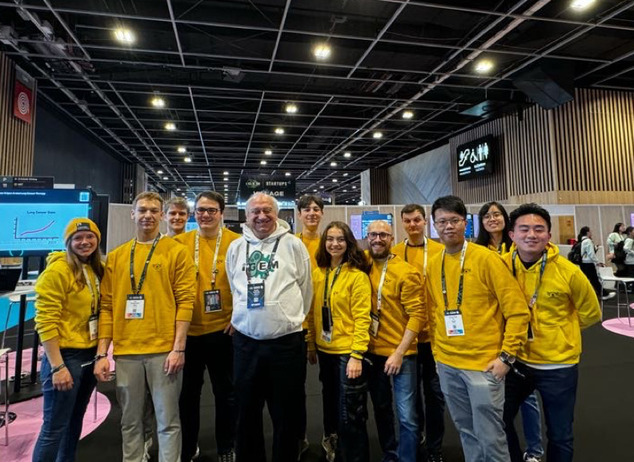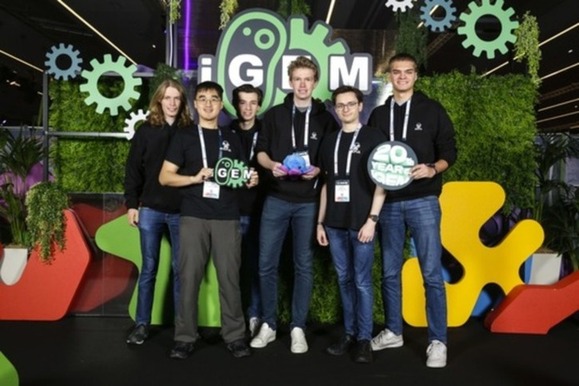Report: iGEM Munich - iGEM Competition 2023
B-Cell Engineering: A Novel Platform Approach
09.01.2024

In our pursuit of transformative medical solutions, this year's focus centers on B-cell engineering — a dynamic approach with the potential to revolutionize disease treatment. The versatility of this platform extends across various health challenges, making it a promising advancement in the medical field.
The Challenge: Diverse Health Threats.
The evolving global health landscape demands innovative approaches to address a spectrum of diseases. From neurodegenerative disorders to viral infections, bacterial threats, and
cancer — our goal was to develop a solution that defies traditional treatment boundaries.
Challenges in existing therapies have inspired our team to explore unconventional avenues. B-cell engineering emerges as a solution that could shift the paradigm, offering adaptability and efficacy in addressing diverse medical challenges.
At the core of our innovation lies a B-cell engineering platform approach, transforming these immune system components into customizable, antibody-producing agents. This platform has the potential to provide a universal approach to combat various diseases.
One of the primary advantages lies in the adaptive flexibility of B-cell engineering. This innovative approach enables tailored modifications, allowing B-cells to target a diverse range of diseases. Unlike conventional therapies with fixed mechanisms, B-cell engineering stands out for its ability to adapt and evolve to meet the specific needs of individual patients. Another noteworthy benefit is the establishment of sustainable immunity. Engineered B-cells contribute to enduring protection, creating a robust shield against recurrent infections. This sustained immune response ensures a prolonged and effective defense mechanism, enhancing the overall therapeutic efficacy.
A critical aspect of B-cell engineering is its capacity to provide a tailored immune response. Genetically modified B-cells empower the immune system to respond with precision to the unique requirements of different diseases. This targeted modulation enhances the effectiveness of the treatment strategy, minimizing collateral damage to healthy tissues. Furthermore, B-cell engineering addresses concerns related to reduced immunogenicity. By leveraging the patient's own B-cells, the risk of immunogenic reactions and rejection is significantly diminished. This intrinsic compatibility enhances the safety profile of the therapy, broadening its applicability across a diverse patient population.
The platform also exhibits prophylactic potential, allowing for proactive treatment measures. This aspect is particularly valuable in high-risk patients, offering a preventive layer of defense against potential diseases. The ability to deploy B-cell engineering as a prophylactic measure underscores its versatility and comprehensive approach to healthcare.
Our platform tackles challenges associated with therapeutic delivery by strategically engineering antibodies. These antibodies feature specialized binding sites designed for optimal transport across biological barriers, enhancing the efficiency of the delivery process.
Emphasizing safety as a top priority, our proposal introduces a medically inducible kill switch. This innovative mechanism allows for the controlled elimination of therapeutic B-cells in the event of any unforeseen adverse effects, providing an extra layer of precaution and patient well-being. In the execution of our experiments, we focus on transitioning from laboratory research to practical application at the bedside. Our proof of concept involves the development of antibodies tailored for specific targets, meticulous optimization of their transport efficiency, and ensuring their stable integration into B-cell genomes. This comprehensive approach aims to bridge the gap between theoretical advancements in the lab and tangible therapeutic solutions for patients.
In conclusion, our venture into B-cell engineering represents a pragmatic shift in medical interventions. By unlocking the potential of the body's immune system, we aim to create a universal platform that addresses diverse health challenges. The journey is ambitious, but the prospect of reshaping medicine is the driving force propelling us forward.
Grand Jamboree in Paris.
When we arrived in Paris, the atmosphere was very energetic and motivating. Everyone was preparing for the upcoming program. On our first day, we registered at iGEM and set up our team booth with a few slides of our work and our sponsors - with a special note at this point to the LMU - on it. Then, we watched the opening show together and subsequently hosted our booth to answer questions to judges and fellow iGEMers. The greatest event on that day was our village presentation: each team from the village, for us this was therapeutics, has the opportunity to present their work on stage. Our presentation can be experienced again under the following link. The next day was probably the most challenging one. We had our judging session. There, we presented our work for five minutes and afterwards critical questions about our project were asked. Our session went well, and we were hoping to have a chance on some trophies. Day three was focused on our team booth since judges would come and ask further questions. Following on day for was the grand jamboree finale. We can proudly say that we successfully reached gold medal status in the iGEM competition 2023 making our efforts worth it.
All of this would not have been possible without the generous financial and ideal support of the Faculty of Biology from LMU Munich, which has provided particular aid to its own students Jan Boltersdorf and Janik Ludwig. A big Thank You for making this opportunity possible!
In the name of iGEM Munich,
Jan Boltersdorf, Janik Ludwig
Our presentation can be experienced again under the following link

Achievements at iGEM
iGEM (International Genetically Engineered Machine) is an annual, worldwide biology competition where teams from around the globe design, build, and test engineered systems to solve real world issues.
Despite being one of the smallest teams in the competition, the MunichBioinformatics Team was able to excel with a nomination and first runner-up for the "Best Software & AI Project" category, reflecting their commitment to innovation and excellence in integrating machine learning, synthetic biology, and biomedicine.
They also received a nomination for “Best Presentation,” highlighting our ability to convey complex scientific concepts and the significance of our project.
Notably, the team was awarded the “Gold Medal,” a testament to its excellence in synthetic biology and the hard work and dedication of our team.
Problem
Polypharmacy is the simultaneous use of multiple, typically five or more, medications [1]. Over 15% of the US population is affected by the adverse effects of polypharmacy [2]. In nursing homes, this situation is even more striking, where over 80% of residents are said to undergo polypharmacy [3].
With an increasing life expectancy worldwide [4], understanding the nuances of polypharmacy will only become more critical in the coming years.
Since the number of possible combinations of different drugs increases exponentially with the number of drugs a patient takes, systematic laboratory testing for side effects is highly impractical.
Past computational approaches have only focused on pairwise drug-drug interactions [5, 6].
Therefore, a computational approach is needed to extend current methodologies to an arbitrary number of medications.
Solution
Our approach uses advanced graph-based deep learning algorithms applied to polypharmacy hypergraphs. These hypergraphs encode biomedical data and chemical language model embeddings, which encode molecular characteristics [7]. This allows us to predict side effects that are caused by the interaction of many drugs, allowing us to capture adverse effects that appear with combinations of two or more drugs.
Using this approach, we reach an AUROC of 0.895 using a pairwise drug-drug interaction dataset from Dacagon [5] and 0.982 for our own multi-drug polypharmacy interactions based on nSIDES interactions [8].
The model’s final predictions consist of the likelihoods of side effects caused by the combination of multiple medications.
More information is available on our wiki: https://2023.igem.wiki/munichbioinformatics.
Results and Impact
Our initial idea for the iGEM competition was to create a model that could predict interactions between drugs and therapies (such as engineered CAR T cells and other gene therapies).
Yet, due to a lack of data and the inherent complexity of modeling the interactions between different classes of medications and treatments, we pivoted and set our sights on the sub-problem of polypharmacy.
Whereas previous approaches focused on pairwise interactions (between two drugs), our method is the first one capable of predicting polypharmacy side effects from an arbitrary number of drugs.
In the absence of established frameworks for evaluating multi-drug interactions beyond pairwise analysis, we adopted a pairwise benchmarking approach, for which results are on par with the current status quo.

